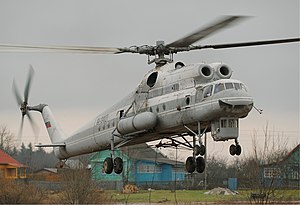Mil Mi-10
| Mi-10 | |
|---|---|
 |
|
| Mil Mi-10K of Vzlet in 2006. | |
| Role | Aerial crane |
| National origin | Russia |
| Manufacturer | Mil Moscow Helicopter Plant |
| First flight | 15 June 1960 |
| Introduction | 1963 |
| Status | Active |
| Number built | 55 |
| Developed from | Mil Mi-6 |
The Mil Mi-10 (NATO reporting name Harke), given the product number izdeliye 60, is a Soviet military transport helicopter of flying crane configuration, developed from the Mi-6, entering service in 1963.
The advent of the Mi-6 gave the Soviet Union the very useful ability to move and place large, bulky or heavy loads with precision. Limitations of the Mi-6 in the flying crane role included a weight to payload ratio and the inability of the crew to easily see the load and its intended final position. A Council of Ministers directive of 20 February 1958 tasked OKB-329 (OKB Mil) with the development of a dedicated flying crane helicopter for carrying bulky loads unable to be carried in the hold of a Mi-6.
The Mil OKB's response drew heavily on the Mi-6, utilising the dynamic components and 4,100 kW (5,500 hp) Soloviev D-25V turboshaft engines, on a slim fuselage sitting on four tall strut braced undercarriage legs, with a wide track allowing the helicopter to taxi over loads, or for mobile loads to be moved underneath. The fuselage can carry 28 passengers inside the cabin as well as 3 t (6,600 lb) of cargo loaded through a side door in the aft fuselage, by an integral boom and winch. Underslung loads can be attached directly to the fuselage by hydraulically operated clamps, or carried on a 8.5 m × 3.6 m (28 ft × 12 ft) pallet lifted by the winch and braced by cables and/or struts to the undercarriage legs. The external sling system, with a capacity of 8 t (18,000 lb), of the Mi-6 could also be fitted under the centre fuselage.
The first prototype V-10 emerged with canted main undercarriage legs with single wheels on all four legs, as well as a retractable emergency escape chute extending below the cockpit and external auxiliary fuel tanks either side of the centre fuselage. As development progressed the main undercarriage legs were replaced with vertical units carrying twin wheels, twin nose undercarriage wheels after a period retaining the single wheels, an Auxiliary power unit (APU) installed behind the cockpit on the starboard side and emergency escape slide cables for use when the pallet is carried.
The first prototype V-10 was completed in 1959 and was soon officially allocated the service designation Mi-10. The first flight took place on 15 June 1960 and flight testing continued successfully until in May 1960 the first prototype crashed during a precautionary landing resulting from loss of gearbox oil pressure, only the Navigator/ radio operator surviving. After joining the flight test programme the second prototype began a series of world record breaking altitude/payload flights for turbine powered helicopters. State acceptance trials were passed successfully in 1961, but production did not commence until 5 March 1964 at the Rostov-on-Don factory, with first flight of a production aircraft on 10 September 1964, leading to a total of forty of the long-legged Mi-10 helicopters built, from 1964 to 1969.
...
Wikipedia
